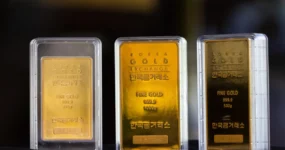BRICS countries are considering ways to promote local currencies in international trade and financial transactions. The group’s work has picked up speed lately and leaders may decide on their path forward at the BRICS Summit in October.
One BRICS currency alternative being considered, the UNIT, would use a gold-backed digital asset on a blockchain to settle global transactions.
HOW THE UNIT WORKS
According to reports following the SPIEF and the June foreign ministers meeting, BRICS is considering a blockchain-enabled payment system that uses a digital asset called the UNIT. Based on the UNIT white paper, each UNIT would be backed by a reserve basket with the following characteristics:
Includes 40% gold
60% balance is made up of participating BRICS currencies which are convertible into gold
No one currency has a greater than 30% weight in gold terms.

A UNIT is created or “minted” at a blockchain-based node when a consumer or investor participant deposits on reserve the corresponding value of gold and participating BRICS currencies. For example, to receive one gold gram equivalent value of a UNIT, a participant would deposit 0.4 grams of gold and 0.6 gold equivalent grams worth of participating currencies (figure 2).
The white paper envisions that UNIT nodes would have a connection to a physical storage hub with adequate transport connections and supporting infrastructure.
The UNIT is not designed to take local currencies’ place in domestic day-to-day transactions. It would work in parallel with established domestic banking and payment systems.
Gold on reserve forever
Gold is the anchor of the ecosystem. The existing gold supply plus annual gold mine production limits the amount of new UNITs created. In addition, as envisioned by the white paper, once gold and local currencies are put into the reserve, they stay there. The one exception to the on-reserve-forever rule is in the case where a node seeks to be bought out. In the case of a buyout, all UNITs returned by the node are canceled and its share of the reserves is returned.

The limited redeemability of the underlying reserves is an important characteristic of the UNIT ecosystem. The on-reserve-forever rule would essentially lead to ounces of gold coming out of central bank reserves, investor portfolios, or the ground and heading straight into permanent storage. This new permanent use case for gold has positive implications for gold miners. Once global investors begin to understand and believe that the UNIT ecosystem will require more gold over time, scarce reserves in the ground should become more valuable.
Re-rating of gold reserves in the ground
Importantly for the mining industry, the on-reserve-forever nature of the UNIT ecosystem would support the demand for gold. The extent of the support will initially depend on the rate of UNIT adoption for use in global commerce. In 2022, the exports of the five original BRICS countries were worth about US$5.3 trillion (China US$ 3.7 trillion).
Based on 2022 trade data and current gold prices, we estimate that for every 1% of market share of BRICS of export trade obtained by the UNIT, just over 250 tonnes of gold along with the equivalent of 385 tonnes of gold in participating BRICS currencies would have to be put on reserve at UNIT nodes.
The actual gold going on reserve at ecosystem nodes would represent almost 5% of the 5,672 tonnes of gold reserves held by the BRICS central banks as of the first quarter of 2024 as reported by the World Gold Council.
Given that most merchandise trade in UNITs would likely be driven by private sector participants, it remains to be seen to what extent central banks would be offering their gold to be used for the minting process. While central banks could conceivably provide some gold initially to help establish the ecosystem, we doubt that they will be running down their reserves as UNIT adoption grows.
As prospective UNIT adoption grows over time, unmined gold reserves would take on added importance considering the critical role gold will play in this new global payment system. Currently, the top three North American gold producers, Newmont (NEM), Agnico Eagle (AEM), and Barrick Gold (GOLD) have just over 7,500 tonnes of gold reserves in the ground as of December 2023. Once mined, those reserves would support the creation of enough UNITs to cover just over 29% of BRICS export trade in 2022.
How would a BRICS currency impact the economy?
A potential shift toward a new BRICS currency could have significant implications for the North American economy and investors operating within it. Some of the most affected sectors and industries include:
Oil and gas
Banking and Finance
Commodities
International trade
Technology
Tourism and travel
The foreign exchange market
How can investors prepare for a new BRICS currency?
Adjusting a portfolio in response to emerging BRICS currency trends may be challenging for investors. However, several strategies can be adopted to capitalize on these trends.
Diversify currency exposure by investing in assets denominated in currencies other than the US dollar, such as bonds, mutual funds, or exchange-traded funds (ETFs).


